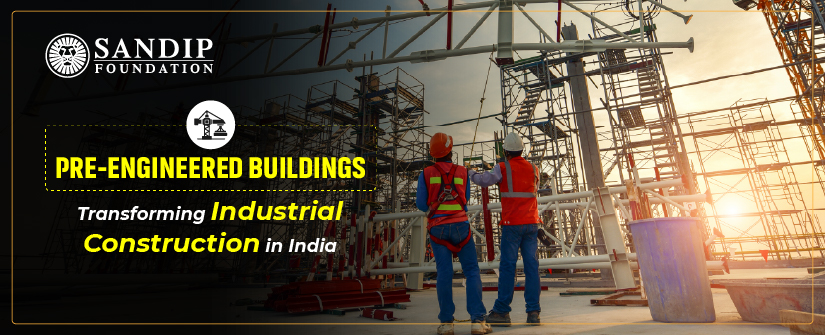With urbanisation happening at fast speed and industrial development in India, there arises a need for an innovative, sustainable, and economical building solution. Pre-Engineered Buildings may be one of those solutions and is gradually gaining momentum in the construction market. Being made in the factory and assembled at the site, such buildings hold incredible efficiency in saving time, money, materials, and flexibility in design.
PEBs are so different from traditional construction techniques, which involve long construction cycles, that they are changing the face of building planning and construction in India. Let is take a look at how some of the best B.Tech Civil Engineering colleges in Nashik inculcate this program in training future engineers:
Pre-Engineered buildings comprise components designed and manufactured by the manufacturer in a controlled factory environment subject to standard processes. They may comprise elements of primary framing (columns and rafters), secondary members (purlins and girts), accessories blanketing roofing and sides such as doors and windows. Once manufactured, these components are sent to the construction site for swift assembly.
Why Pre-Engineered Buildings?
The adoption of PEBs is driven by a multitude of factors:
- Speed of Construction: PEBs can be erected much faster than conventional buildings. Therefore, reduced erection time implies faster occupancy and faster return on investment.
- Cheap and Efficient: Since PEBs use high-strength steel and an optimised design process, they lessen raw materials consumption, labour costs, and construction overheads.
- Design Flexibility: PEBs offer modular design systems, thus the structures can be used for applications varying from small workshops to large industrial complexes.
- Structural Performance: They are also said to provide great structural performance under the action of seismic, wind, and environmental forces being lightweight but strong.
- Quality Assurance: The majority of the fabrication is carried out in a factory setting, where quality is controlled so that the finish will be the best possible traditional building firms can provide and so that the specifications laid down in the design are adhered to.
Important Benefits of Pre-Engineered Buildings
- Time Savings: With the construction time being reduced up to 50%, this supports rapid industrialisation and business expansion.
- Sustainability: Steel is 100% recyclable. PEB construction supports sustainable concepts that promote a disease-free environment through less carbon footprints and green materials.
- Low Maintenance: Components are galvanised and painted to resist corrosion. It will lower the operating life cycle maintenance costs.
- Adaptability: Structures may be easily expanded or modified to accommodate changing functional needs.
- Aesthetic Options: Modern PEBs permit archaeological enhancements assigning aesthetic value to structural integrity.
Applications of PEBs in India
The versatility of PEBs makes them suitable across multiple sectors:
- Industrial Sheds and Warehouses: These are the most common applications where large, column-free spaces are essential.
- Educational Institutions: Schools and colleges adopt PEBs for cost-effective infrastructure development.
- Healthcare Facilities: PEBs support the construction of modular hospitals and health centres, especially in remote or disaster-prone areas.
- Retail Spaces: Showrooms, malls, and exhibition centres benefit from the flexible layouts offered by PEB designs.
- Agricultural Infrastructure: Storage silos, cold storages, and dairy units are increasingly being built using PEB systems.
- Residential Projects: In hilly and challenging terrains, PEBs offer lightweight and stable housing solutions.
India’s Growing PEB Market
There lies the paradigm shift in India’s infrastructure sector with a focus on Make in India, Smart Cities, and industrial corridors. These initiatives have resulted in an increasing demand for aggressive and sustainable engineering methods. The PEB industry is growing at a double-digit rate, with a projected market size of over USD 4 billion in the coming years.
States such as Maharashtra, Gujarat, Tamil Nadu, and Telangana are emerging as potential states for the manufacturing of PEB. There are large-scale industries present in these states, as well as friendly PEB policies. Some important players in this industry are Tata BlueScope, Kirby Building Systems, Jindal Buildsys, and Interarch, which have been augmenting their capacity and investing in R&D to provide better and more advanced solutions.
Technological Advancements in PEBs
Recent developments in materials, software, and construction techniques are redefining the PEB landscape:
- BIM (Building Information Modelling) is enabling more integrated and accurate planning.
- Cold-formed Steel and High-performance Coatings are enhancing durability and weather resistance.
- Smart monitoring systems are being embedded in structures to track load, stress, and environmental conditions in real time.
- Automation in fabrication is reducing errors, improving safety, and increasing scalability.
These advancements are not only improving structural reliability but also making PEBs more attractive for high-rise applications and aesthetically demanding projects.
Future Prospects of PEB in India
The future of PEB in India is in line with the global trend of modular, green and technology-led construction. While construction techniques and materials may need to be adapted to local conditions and desires, the need to build efficiently, and affordably only makes sense and, as urbanisation continues and land becomes increasingly hard to come by, the more imperative it will become.
Prospects for the future include potential new growth in the following areas:
- Green Buildings: Use of solar panels, rainwater harvesting and energy efficient insulation in PEB.
- Public Infrastructure: Support in Railway Stations, Airports and Bus Terminals.
- Resilient Buildings: Prefabricated shelters and rehabilitation centres in seismic and flood zones.
- Defence and Remote Infrastructure: Rapid in border & unreachable areas.
Conclusion
PEBs provide an ideal alternative to India’s growing construction needs. Incorporating structural efficiency, speed, and value, PEBs ensure the economic and environmental well-being of present and future generations. Many top civil engineering colleges in Maharashtra have included this topic in the curriculum to help students gain relevant knowledge and skills in this field.
With the country moving towards environmentally responsible urban and industrial development, PEBs are bound to play a more significant role. Funding for raising awareness, conducting research and supporting policy will be crucial to harness the Indian application of a disruptive technology.

